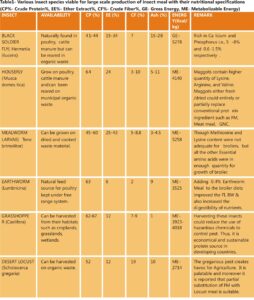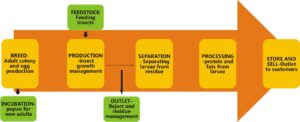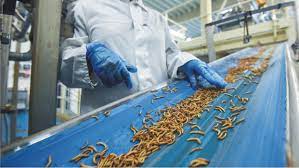USE OF INSECTS AS AN ALTERNATIVE IN POULTRY NUTRITION: A VIABLE SOURCE OF PROTEIN ALTERNATIVE
Protein sources are second largest component of Poultry diets. Due to limited distribution and expensive nature, usually Poultry is depriving of a rich protein source. Soya bean seed is the premier protein source followed by Fishmeal used by poultry industry. Seeds are rarely used, rather the residue after oil extraction i.e., Soya bean meal (SBM) is usually fed to poultry. Owing to limited no. of producers and demand, the price of SBM is high and tends to fluctuate with changes in climatic condition. Similarly, Fishmeal is based on fish cultivated in aquaculture or marine fish. Due to overgrowing population and scarce conventional protein sources, it is the need of the hour to shift the focus towards identifying alternative protein sources. Insect protein is one of the very apt alternate protein sources that can be explored and brought in usage for poultry industry.
Rising feed cost and growing protein demand is a challenge for the global poultry industry. Using insect meal as an alternative source of protein supplement in poultry/animal feed will be a feasible option in years to come Most of us would understand the challenges poultry industry will face from rising costs of conventional feed resources, and concerns regarding limiting supplies in the future will be limited. Demand for meat, milk and dairy products continue to grow therefore it is always a concern as to look for some viable options regarding animal feed. Situation becomes all the more concerning on threats of limited availability of natural resources, adverse weather likelihood and increase in competition between human food, animal feed and bio-fuel, in terms of land and water availability.
Finding Alternative Source
Due to overgrowing population and developing industries, justby relying on traditional sources such as Soya bean meal, Fishmeal would make the sources scarce and expensivein near future. Therefore it seems indispensableto consider alternative protein sources to fully or partially replace the conventional sources in poultry feed, Generally, a product fits in the category of competent alternative protein substituent in poultry if it is in good supply, reasonably priced and has proper nutrition level. However there is some nutritional and technical consideration that determines the competence.
- Nutritional aspect- Essential amino acid balance, presence of naturally occurring Anti nutritional factors such as tannins and enzyme, presence of pathogens and need for supplementation.
- Technical aspect- Availability and supply throughout the year, bulkiness and wetness &/or powdery texture processing requirement, predicted availability of ingredients in long-term, consistency in research and development efforts.
- Economical aspect- Farmers may use on farm waste such as crop leftovers as input for insect production and add resulting flies larvae to feed their livestock. With limited space, resource, poor farmers can engage themselves in insect farming and increasing their productivity while contributing to waste management.
Insect meal fulfilling these aspects stands out to be the very next alternate solution for scarce conventional protein sources.
What is Insect Meal?
Insects being used as an alternative protein source for poultry and aqua industries. Insects are either fed as a whole or processed such as in powdery form, either fed as fresh or dried. Insect meal is being a great startup for entrepreneurs where protein and fat is extracted from insects and processed. E.g., INSECTFii, a company piloting in India uses Black soldier fly larva and convert organic waste that is obtained from urban areas into high value insect protein, that replaces water and climate intensive plant protein as well as over harvested and depleting fish protein used in animal feed. next Protein is a company that produces insect-based protein for animal feed stocks in order to develop sustainability in agriculture and tackle resource scarcity.
| PROTEIN SOURCE | CRUDE PROTEIN (%) | CRUDE FAT (%) |
| Black soldier fly | 35-57 | 35 |
| Common housefly | 43-68 | 4-32 |
| Yellow mealworm | 44-69 | 23-47 |
| Fishmeal | 61-77 | 11-17 |
| Soybean meal (defatted) | 49-56 | 3 |
Growing Importance of Insect Meal as a protein source:
Insects, as proved scientifically are a protein-rich food source and have been used to supplement both the diets of animals and humans since centuries actually. With world population expanding, one has to meet the challenge of feeding the world’s increasing population, and also address the issue of protein requirements. In developing nations, the middle class segment are demanding more animal while the less-developed nations face the problem of a protein deficient population. Under these conditions, there is growing importance of insects to be largely widely for producing cost-effective, and abundantly available protein source to the poultry feed industry.
Presently there is greater focus on Black soldier fly (BSF) (Hermetica illucens) and the common housefly (Musca domestica), and in large-scale facilities the larvae are harvested first. They are then cooked and/or dried before being turned into a meal. In terms of food conversion, insects are highly efficient as per studies.
Insect Protein- A Sustainable Alternative Protein
Fly larvae can be reared on a wide range of wastes and byproduct, offering a way of recovering values from material that may traditionally be disposed of by Agriculture and food industries. Moreover, as far as environmental impact of insect industry is concerned, compared to Fishmeal production, Housefly and Black soldier fly production have shown favorable results regarding impacts on fossil fuel depletion, Freshwater and marine eutrophication and ecotoxicity and natural land transformation.
Nutrition composition of insects depends on growth, environmental growing conditions, as well as the life stages. E.g., When Methionine content of housefly larvae grown in Poultry stools, it was found to be higher than that grown in various vegetable residues. On average, insects can convert 2 Kg of feed into 1 Kg of insect mass, whereas cattle require 8 Kg of feed to produce 1 Kg of body weight gain. Protein levels in insect meal vary between 55%-75% (levels comparable to animal protein i.e., meat and bone meal and fish meal sources). Feed incorporation rates range between 5-40% for aqua and broiler feed. Production of one metric ton of Housefly larval meal replaces .5 metric tons of Fishmeal and .5 metric tons of soyabean meal.

Industrial Scale Production and Process Control
Food waste should be avoided as much as possible in the chain from food production to consumption. However from farm to fork some waste is unavoidable. In rural areas, agricultural by products and wastes from farming will be available while in urban areas it will be from distribution centers and final consumers. This waste can be used to feed insects. The dried insect larvae are then used in chicken feed. In developing countries, poor urban people can collect food waste (usually for free) and use it to farm insects. Smallholder farmers usually depend on external sources for feed, including National & International feed companies which usually cost them expensive. Fly larvae maybe produced locally by smallholder farmers that opens their door to become feed supplier in addition to/ or instead of being feed buyers. This helps in gaining income from producing fly larva as feed component and to improve livelihood and food security of smallholder farmers. In this way this strategy works at three levels: reduce the disposal of waste in the city, provide cash income opportunities and improve nutrition. This strategy of economical sustainability sooner or later can be developed from ‘hobby style’ to industrial scale and process control. Most companies are exclusively dedicated to insect production and fully integrate all production steps from farming up to delivery of insect meal or oil. A startup can be established by smallholders with limited input to generate insect meal for animal feed and the residue from insect meal cam be used as organic fertilizer for crop production. Insect production by smallholder farmers may both somewhere disconnect them from the conventional external input such as Fishmeal and Soyabean meal based feed as well as connect them to local economies by selling insects to local livestock farmers as well as feed millers.
Thus insect rearing and farming proves to be an economical pavement and moreover should be explored for new employment and revenue generation.
Insects, specifically black soldier fly larvae (BSFL), could be an ideal protein-rich alternative for soy, due to their high nutritional value and the low requirement for breeding space. BSFL are an excellent energy and protein source (37% to 65% protein) and it has been stated that their amino acid profile is more suitable for poultry (Barragan-Fonseca et al., 2017; Schiavone et al., 2017). However, BSFL contain chitin that can negatively affect protein digestibility and, therefore, can be detrimental to animal performance.
Effect on growth performance
Several studies have been undertaken to determine whether BSFL is suitable as poultry feed ingredient and as alternative to soy. Dabbou and colleagues (2018) conducted a longitudinal study with dietary BSFL meal inclusion on broiler chicken growth performance, blood parameters, and intestinal morphology. In the study, 256 male broiler chickens were fed with four different inclusions of partially defatted BSFL meal from day 1 until day 35:
- test diet with 0% BSFL meal inclusion,
- with 5%,
- with 10%, and
- with 15% as substitute for soy (and corn gluten meal).

The diets were isonitrogenous and isoenergetic (same nitrogen and caloric content across diets). The results of this investigation suggest that inclusion of dietary BSFL meal up to 10% in male broiler chickens increase live weight and daily feed intake, however, only during the starter period (day 1 until day 10). During this period, the growth and development of chicken was much faster than in the subsequent periods (growing period from day 10 until day 24, and finisher period from day 24 until day 35). The increased feed intake and live weight gain was attributed to the improved diet palatability. It has already been reported that chicken seem to prefer feed that includes BSFL meal. During the growing and finisher period, the feed conversion ratio and live weight of the 15% BSFL group were negatively affected compared to 5% and 10% inclusion groups. It was hypothesised that the chitin content in the 15% BSFL meal diet could have negatively affected protein digestibility (Dabbou et al., 2018). In contrast, another study found that live weight and carcass weight of broiler chicken fed with 16% defatted BSFL meal inclusion were higher than the weights of control chicken after 34 days (BSFL substituted for soy). Here it was suggested that the higher amount of crude protein was most probably the cause and the chitin content, which did not seem to impact protein digestibility (Altmann et al., 2018).
Broiler meat quality
Altmann and colleagues (2018) analysed the change of meat quality and sensory properties of breast fillet of broiler chicken packaged according to the current industrial packaging practices with highly oxygenated modified atmosphere packaging (HiOx MAP) over time. Breast fillets of broiler chicken that received defatted BSFL meal as replacement for 50% of the soy (total inclusion during starter period was 19.5% and during grower period 16%) seemed to have a more intense flavour when it was fresh compared to breast fillet of the control group (no dietary BSFL meal inclusion). The flavour intensity decreased 3 days after packaging and then again 7 days after packaging. The flavour intensity of breast fillet of the control group also decreased from 3 days after packaging, but, curiously, was found to be increased again after 7 days. No explanations for the continuously decreasing flavour intensity of breast fillet from the BSFL group were given. However, it was stated that less flavour intensity could be a selling point, as it is preferred by some consumers. Further analysis found more stable pH levels in breast fillet from the BSFL meal group from fresh until 7 days after packaging compared to breast fillet of the control group. It was hypothesised that BSFL inclusion could result in in longer shelf-life.
Effect on egg production
Dietary inclusion of defatted BSFL meal also impacts egg production. In an 8 week investigation in 108 individual 19 weeks old pullets (Shaver White) that were fed a standard corn–soybean meal diet, defatted BSFL meal was included as substitution for soybean at 5% and 7.5%. Here, corn was gradually increased with reduced soy content and increased BSFL content. However, the authors did not state the reason for these changes. This could have been done to meet the nutrient requirements for 19 weeks old pullets (according to Shaver White commercial management guidelines) and to create iso-caloric and iso-nitrogenous diets. Nevertheless, the results showed that defatted BSFL meal inclusion of 7.5% resulted in similar egg production, average egg weight, and egg quality parameters compared to the control diet (analysed at day 5 of weeks 22, 24, and 26). In contrast, 5% inclusion resulted in significant lower daily egg production. Egg weight and egg mass were also significantly lower than for eggs laid by control hens. The similar results between control and 7.5% BSFL inclusion group were attributed to the significantly increased feed intake of hens of the 7.5% BSFL inclusion group compared to the control and 5% BSFL inclusion group (Mwaniki et al., 2018). Mwaniki et al., 2018 showed that yolk colour, shell breaking strength, and shell thickness were significantly increased when BSFL were fed. The increase of these parameters could have been caused by increased calcium absorption and/or calcium metabolism in the gut of the hens.
Insect production
Black soldier fly (BSF) (Hermetica illucens) and the common housefly (Musca domestica) are two insect species mainly being investigated.
The flies are bred, eggs laid and larvae hatch – all under controlled conditions at around 30 degrees Celsius. The larvae are then fed until they reach a suitable size (e.g. in the case of BSF, they reach two centimeters in two weeks). BSF can be reared on variety of food or animal waste; the housefly is usually fed on manure or abattoir waste.
Insects have impressive life cycles: a female housefly lays 750 eggs a week and the larvae increase in weight over 400 times in just a few days; and BSF can develop from egg to adult in 38 days.
In large-scale facilities the larvae are harvested, then cooked and/or dried before being turned into a meal. In terms of food conversion, insects are highly efficient.
Commercialization of insects for feed
Innovation in mass-rearing systems is taking place in many countries. China already produces insects for use in aquaculture. In Western Europe, insects are reared for pets and zoo animals as well as for fishing bait. In developing countries, small-scale businesses already produce insects to be sold as poultry feed. A company in the United States is using DDGS as a food source for BSF and is already selling its high-protein larval meal for use in aquaculture.
Large-scale insect production is not just blue-sky thinking, but the subject of discussion for the Food and Agriculture Organization (FAO) and research institutes internationally. PROteINSECT, for example, aims to create a pro-insect platform to share experience and expertise in rearing, processing and using insects as a component of animal feed. With partners in Europe, Asia and Africa, the group is focused on optimizing rearing systems for insects; ensuring the quality and safety of insect meal; and demonstrating its efficacy in monogastric nutrition.
Life-cycle analysis will also be a focus as a way of assessing the environmental impact of insect protein production processes.
Nutritional value
Insect meal is rich in protein (40 to 50 percent) with a greater concentration of essential amino acids than soybean meal (Table 1).
Relative to lysine, BSF meal contains higher levels of threonine, valine, isoleucine and leucine when compared to fishmeal. Insects are also relatively high in fat, supplying energy at levels comparable to, if not higher than, that of cereals or legumes.
The metabolizable energy value of housefly maggots was evaluated in two trials (14.2 MJ/kg DM; 17.9 MJ/kg). Total tract amino acid digestibility is high, between 91 and 95 percent, but individual amino-acid digestibilites for poultry have yet to be determined.
Conclusion
International Feed Industry Federation (IFIF 2016) predicts that livestock production will get doubled by 2050. Therefore in order to meet future requirement, need of hour is to explore new protein sources. Poultry that have access to outdoor areas voluntarily pick and eat insects which clearly indicate that they are evolutionarily adapted to insects as a natural part of their diet. Production of fly larvae is based on waste streams as input. Usually the waste streams ends up in landfills leading to environmental damage. Producing insect for feed yields a residue after harvesting the larvae that can be used as fertilizer. Thus, insect meal production proves to be an economical employment option with eco friendly trait that should be explored. Due to high nutritive value and ubiquitous presence, insects are potential sustainable feed resources in poultry nutrition. Value of insects as feed component not only improves livelihood of small farmers but also reshapes food system into efficient climate resilient and nutrition driven element of a circular economy. Inclusion of insect meals in poultry diets may lower the cost of feeds, thus resulting to more profit for smallholder poultry production, then why there should be any delay and restriction to open that door and to explore the area.
DR SK RANA, POULTRY CONSULTANT,PUNJAB
References are available upon request.
IMAGE-CREDIT GOOGLE


